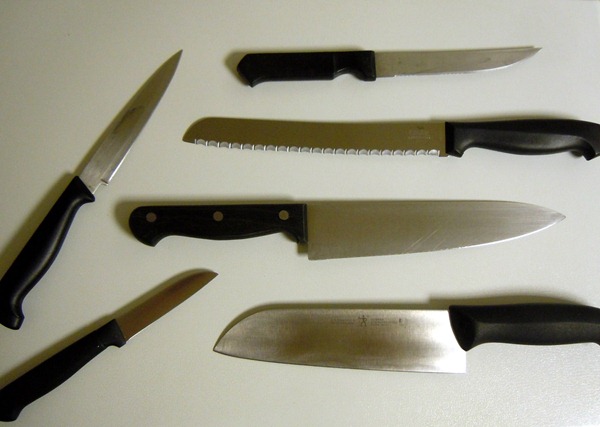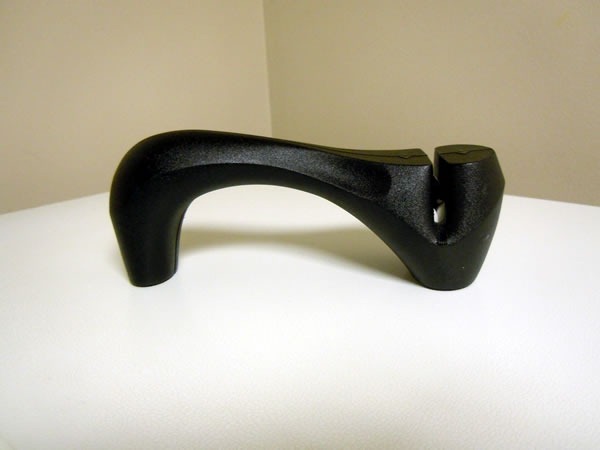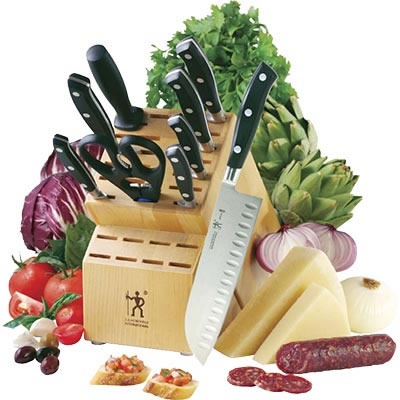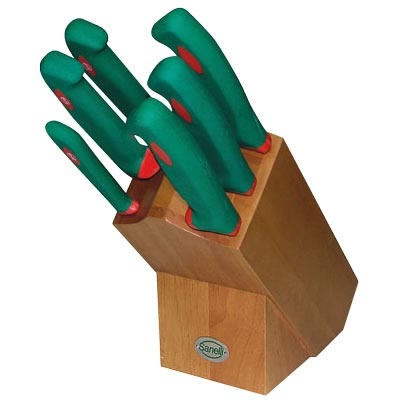 Click the photo to get a closer look at these knives in all their former glory.
Click the photo to get a closer look at these knives in all their former glory.
I find myself in a situation where I have no kitchen knives save a motley assortment from my “Bachelor 1.0” days, all of unknown provenance. My guess is that they’ve come from the dozen or so housemates I’d had over the years. I hear that the young people, like these two, might refer to them as “janky”. The knives have been kept in a drawer for years (the good ones lived in a proper knife block). The photo above shows the sharpest of the bunch, based on some experimental onion-slicing.

While cleaning out the kitchen, I found this modern-art-looking-thingy. It’s a knife sharpener, and like the knives, it too is of unknown provenance. I ran the santoku-ish knife (in the topmost photo, it’s the one closest to the lower right-hand corner) through it a half dozen times and it seemed to do a better job at slicing onions. Of course, this may just be a placebo effect and I may have made the knife even more worthless. Time will tell.
 “Knives” Chau from Scott Pilgrim vs. The World.
“Knives” Chau from Scott Pilgrim vs. The World.
I can easily go out and buy a new set of knives, but I plan on making do with the janky set for as long as I can. In fact, The Current Situation is such that there’s a lot of household stuff that I need to replace, but I’m resisting the urge to make a beeline for the store. My reasoning is as follows:
- Holding off on replacing those household items buys me time to do a little research. I can read reviews, shop around, and as you’ll see in just a moment, call on the collective smarts of my readers.
- Holding off also buys me time to find out what things I used to have that I don’t really need. Whatever I need will become glaringly obvious through its absence and I’ll buy it. Whatever I don’t need will neither be missed nor bought.
Gentle Readers, I’d love to tap your collective smarts: do you have any recommendations for knife sets? I’m no chef by any stretch of the imagination, but I cook a lot. I work from home a fair bit, so not only do I prepare dinners at home, I also find myself in my own kitchen for lunch. While I’m not aiming to buy an expensive set, I know better than to go cheap.
I did a quick check of the Costco Canada site and found these two sets that were in the neighbourhood of what I wanted to spend. The first is this ten-piece Henckel set, which sells at Costco for CDN$200:
Here’s what’s in this set:
- 23-slot birchwood knife block
- Vegetable knife: 7.6 cm (3 in.)
- Paring knife: 10.2 cm (4 in.)
- Utility knife: 12.7 cm (5 in.)
- Santoku knife (with Granton edge): 17.8 cm (7 in.)
- Carving knife: 20 cm (8 in.)
- Chef’s knife: 20 cm (8 in.)
- Bread knife: 20 cm (8 in.)
- Sharpening steel: 23 cm (9 in.)
- Kitchen shears
The second is this nine-piece Sanelli set, which also sells at Costco for CDN$200:
Here’s what’s in this set:
- 1 oak wood block
- 1 flexible fillet knife: 19.7 cm (7.75 in.)
- 1 narrow boning knife: 15.9 cm (6.25 in.)
- 1 roast knife: 24.1 cm (9.5 in.)
- 1 bread knife: 24.1 cm (9.5 in.)
- 1 japanese knife: 17.8 cm (7 in.)
- 1 paring knife: 10.2 cm (4 in.)
- 1 Edgemaker®
- 1 Castor peeler
Do either of these sets make sense? Are there better sets at the same price? Is it a fool’s dream to hope to get the right knife set for me at the the CDN$200 price point? Should I forget sets, go to a “proper” kitchen store and perhaps build a set, spending more and building a set a knife or two at a time?
Let me know what you think (especially if you’re a chef or very avid home cook) in the comments!


25 replies on “Your Knife Opinions, Please”
Henckel… and hang on to the funky knife sharpener
Not being an expert in the retail scene in Canada I’ll leave that to other people.
My experience is that in knife sets you get a complete range of middling to average knives. And they always include some knives you will never use.
My preference would be to buy individual knives (and maybe a block) as you go. For instance, I really only use four differents blades – a chef’s 7in, a 3in vegetable knife, a 4-5in utility knife and a bread knife. So when I get some money next year I’m going to replace only those.
Oh, and you need a steel.
If I spent more time in the kitchen I’d also consider a boning knife for getting the skin off fish but that would be about it.
You might consider asking on http://cooking.stackexchange.com — though I’d be careful to generalize it as “teach me how to buy good knives” and not a shopping recommendation.
I would agree that knife sets, unless you;re ready to drop a bundle, are not going to serve you well. A single high quality 8″ chef’s knife or 6.5-8″ santoku will probably cover 95% of your needs. Add a cheap-ass very sharp paring knife and maybe a bread knife if you slice a lot of bread. I love my 8″ Wusthof chef’s knife and my 6.5″ Shun santoku. Hone them regularly – get a real sharpening done once or twice a year. Either will last a lifetime if not mistreated. I pretty much started buying 1 knife every year or two as I found that I needed them, always picking out something of high quality. My knife collection is now fairly extensive but a lot of them are for specialty tasks (like the sushi knife for paper-thin even slicing) but nearly everything is done with the two knives listed above and, really, either one on its own would suffice just fine.
Also, I find blocks to be a waste of space and they can easily get unsanitary. Wall-mount magnetic knife strips are my preferred storage method – they take up no real space and the knives are always at the ready. My current kitchen is not well-suited to them so I have a flat blockish thing in a drawer but have also used slip-on plastic sheaths as well (particularly nice for transporting them so as to be safe for you, your other stuff and the knife edges.
I can only second what Andy wrote. I cook a lot at home, and I use mostly a Chef’s knife (9″), an Office knife (maybe 5″), and a small (2-3″) carbon steel vegetable knife (they rust if not kept dry, but are cheap, very sharp, and stay sharp without sharpening). I also bake bread and have a serrated bread knife, but that is less important. Those three knives and a good steel are enough, but could cost 200$ if you chose good quality that lasts for the rest of your life (one of my knives is 30 years old).
Of course, as a German I must tell you that the only serious kitchen knives come from the city of Solingen, Germany. Some of the brands are sold in North America, too, such as Wusthof and Zwilling (Henckels). For some knife porn, look at
http://www.guede-solingen.de/english/guede-eng.html
A good steel is enough to sharpen, but every other year, bring the knives to an expert. Read this, for example:
http://articles.sfgate.com/2010-12-20/entertainment/25209883_1_dull-knives-knife-diamond-stones
I have a motley assortment of knives, picked up here or there, or inherited from family members. The inherited ones tend to be the best, once they’ve been given a decent edge. I’ve also picked up some high-quality (and, ackk, high price) blades over the years. But the rule of thumb is: You can pay high prices for average blades, but you can’t pay low prices for above-average blades.
Having said that, one of my most useful knives is a cheap plastic-handled paring knife I picked up from — yes, really — the dollar store. The blade might not keep a sharp edge for long, but a few strokes on a sharpening stone gets it right back. And being cheap, I feel okay using it for things I’d never touch with my more expensive blades. (Most recently, cutting styrofoam!)
Henckels has 2 lines: the German one identified with the “twins” logo and the International line identified with a different logo.
http://en.wikipedia.org/wiki/J._A._Henckels
The German made products are their very best and they are very expensives. To me, the Costo set has way to much items for $200, one good knife usually selling for $75-$150.
I have a Sanelli knife and I like how it feels in my hand. I’m not sure how to describe that but they just “feel right” when you use them. Something like the difference between a Squier and a Fender. So between the 2 sets, I’d go for the Italian one.
Happing cooking!
I’m with Andy, except I like to have two knives in the 6-8″ range, one wide, one thin. My preference for meat is using the wider one. If you become a serious paleo caveman type, you might consider a butcher’s knife, but that’s about it really. There’s probably knives as good as Henkel, but you can’t go wrong buying Henkels.
I have a Sanelli flexible fillet knife myself, which I purchased specifically for slicing smoked salmon. It is an excellent knife; it keeps a nice razor-sharp edge for a good long time, and it is very comfortable to use.
I agree with the others here that a good chef’s knife is a better investment than a set of knives; spend $150 on a single decent knife rather than $200 on a set of something just okay. You can fill in the rest of your collection as you find yourself needing them (e.g. paring knives, boning knives, utility knives, etc.)
But if you would rather start with a set of knives just to get a reasonable selection quickly, I would definitely take the Sanelli set over the Henckel one, no question.
Agreed with all above on the utility of individual knives versus a set. As for make, my most-used knife is a Henckels chef’s knife from the “Professional S” series. I find that some of their series have too-light handles that just don’t feel right when I use them, but the Professional S has a good weight. Recommend that you at least heft them (if not actually try them out) before you buy to see if they feel right in your hand.
Go to a restaurant supply shop or outlet store and buy three knives, brand doesn’t matter but buy quality (guesstimate: $20-$45 US per). A chopper, a good mid-sized meat slicing knife, and a bread knife. Get a magnet to hang them on. Done.
I’m not a fan of plastic handles, so I’d give away or recycle the lot you have, maybe send the one in the middle with what appears to be a wooden handle to a professional sharpener. Never EVER buy “never sharpen” knives. They shred rather than cut. You should sharpen knives reflexively as you use them, with a simple, rod-style sharpener. If you notice what butchers use, it’s always plastic handles and good steel, and they sharpen all day. I don’t like plastic because it melts in the washer. I hand-wash knives anyway, since wood splits in hot water.
The rest is consumerist knife porn. I own a block full of knives (a gift) and use three of them regularly. A wood block is basically a germ repository. As soon as I see a cheap knife magnet in my travels, the block is gone.
About a decade ago, we bought a set of Cutco knives. They were expensive – and great. I need to send the serrated ones in for sharpening, but it’s (almost) free, I just have to get around to it.
I’m not saying they’re the best out there because I haven’t used a lot of others, but most of the time I use knives at friends houses, I’m happy to use mine afterwards.
If you buy individual knives, Lee Valley Tools has a great knife block that you should look at:
http://www.leevalley.com/US/garden/page.aspx?p=60774&cat=2,40733,40738&ap=1
I haven’t used it, but
a) Lee Valley makes/sources great stuff
b) The design of this knife block looks great.
Personally, I’m thinking about getting two of those knife blocks, and purchasing a couple of extra Cutco knives.
I second the “buy piecemeal” approach when the need for a new knife arises, starting with a medium or big chef, a mid-sized santoku and a serrated bread knife. When in doubt, go bigger. Oddly, a longer knife is easier to use.
Skip the storage block; the magnetic bar wall storage option is the way to go, or the plastic sheaths to keep the edges safe from inadvertant dings.
The best line I’ve read on sharpening a knife:
“Don’t use a home sharpening machine unless you feel your knife has wronged you in some way and must be punished.”
Bin the new-agey modern art thingy. Now.
source: http://gizmodo.com/5348996/youre-doing-it-wrong-how-to-properly-buy-maintain-and-use-a-knife
The Chicago Reader had an article covering similar suggestions: go cheap on paring knives (disposable item) and on cleavers (it’s a cleaver, sharpness isn’t its selling point).
Happy slicing!
personally i like blocks and knives and all things about them and probably have way too much because of it.
my suggestion is that you check out ikea. i got a block from them that got me a nice medium quality set of knives. for about $50.
in addition to that i have my ‘good’ knives. spend some real money on a nice chef knife – about $100 or so.
pairing knives are indeed better cheap and having 3 of them isn’t a bad thing. you’ll find lots of things to use them for and cleaning up between things isn’t so good.
one longer serrated knife for breads and other things that are hard to cut is a good plan.
getting a thinner carving knife is also good if you’re going to be making many roasts and things but you can get most of these in the block set.
don’t really consider a block set iwth more than the 6 basic knives. the rest are for suckers.
This link may be of interest:
http://www.cookingforengineers.com/article/39/Kitchen-Knives
from the looks of it the knives in your janky set aren’t all that bad (is that a henkel or a wusthof?), but you’ll need a good sharpener.
agree with most of the above re: brands and what you actually need (totally against sets), my preferred brands are wusthof and global. global’s are excellent knives, a bit $$$ but you will never need another knife. http://www.global-knife.com/
i think you can get them at williams-sonoma and the knife guy in kensington mkt.
I have the Lee Valley knife block that Justin linked to above and highly recommend it. I also have their knife sharpener, which does regular and serrated blades. My knives, however, cost less as a set than the sharpener.
I’m no Gordon Ramsay, but I’ll second the piecemeal approach. I have a set of knives (and a relatively cheap one at that) in a block, but find I use 3-4 individual pieces (from my own janky set that lives in a drawer) far more often. Better to blow your dough on a couple of good ones you’ll use habitually, and forego the nice-looking but largely useless block full of stuff you’ll only use once in a while.
Bet you didn’t expect this to become a raging thread…
I’m one more vote for one good knife. Like Michel I’m a fan of global knives, the important thing is to try some out. Go to a good shop (Dinetz on King is pretty good ) and ask to handle a few. You mainly want a good chef’s knife — as others have said, paring knives are cheap and disposable — and a decent boning knife. But, for god’s sake, no self-respecting bon-vivant should be ignorant of the simple art of knife sharpening: get a water stone at Lee Valley and practice a little. You will be master of your destiny and women will admire you. Just saying.
Hey Joey,
You’ve already had several weigh in saying pretty much the same thing, but thought I would add my two cents.
We cook a lot, and as you know, I did run a resort for a couple of decades. Honestly, we make do with a good chopping knife (the size of the one you have in the photo just below the serrated bread knife), a good paring knife and a nice serrated bread knife. We never need anything else.
Keith says that if you eat large dead animals (e.g. a roast or turkey), then you will want a carving knife – not something we ever need, obviously.
All our knives are good-quality Henckels. And we have one steel the we just use regularly. I’m sure we should have them sharpened up professionally regularly, but so far so good.
Guy’s suggestion is a good one – it does seem vaguely manly when a man knows how to put a good edge on a knife.
As for the block, if you go with that, put the knives in upside down in the block. That way you’re not running the sharp edge along the wood every time you put your knife away.
If you take a look in the kitchen of your favourite restaurant, you won’t see them chopping up veg with a $250 japanese santoku. Beautiful knives are nice to have for the art value and the feeling of quality, but if you just need to chop stuff, head over to a restaurant supply store (Tap Phong has a great selection) and grab a couple plastic-handled commercial kitchen knives.
You’ll want a chopping knife (8-10″ chef’s), a paring knife (get a few because they get used for everything), a serrated bread knife, and maybe a nice thin slicing knife. The Henckels commercial ones with the yellow handles are fine.
Get a block or a magnet for safe storage (they shouldn’t go in a drawer), and a steel to hone them before each use. You’ll be out about $150 for the kit, but they’ll be good for a lot of safe, worry-free food prep.
Probably better to get a $200 chef knife than a $200 set since you use that knife 80-90% of the time. Plus then you have the option of a 9″ which people seem to recommend.
There’s a guy in Montreal I bought a knife from after googling around and finding some knife geek forums. I got the Grand Cheff and it’s great. There’s a guy on Queen St. that sharpens and sells Japanese knives too. I’ll use him once the thing finally dulls—it stays really sharp with just a ceramic hone.
http://www.paulsfinest.com/
http://knifetoronto.com/
I agree that you don’t need an entire knife block. Get a 6 or 8″ chef’s knife. That’s it. Perhaps a bread knife and/or a paring knife.
My current knife block is one of those one-size-fits-all blocks – similar to this one.
I just bought a new knife – Calphalon – at Home Sense when really I should have just gotten my other knives sharpened. You can get knives at Loblaws these days and they’re just fine. Just treat them well.
To echo Andrea’s sentiment, Chef Michael Smith says you only really need three knives in your kitchen:
A chef’s knife, which you’ll use 90% of the time;
A serrated knife, for cutting bread; and
A paring knife, for smaller jobs.
I would check out the Mark Bittman’s kitchen starter kit video –
http://www.nytimes.com/interactive/2011/01/26/dining/20110126-bittman.html#Kitchen_Starter_Kit_%282007%29